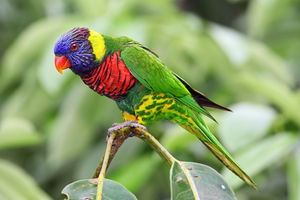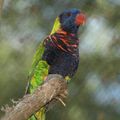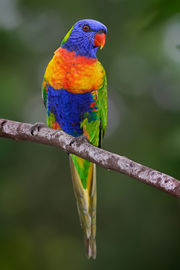Rainbow Lorikeet
| Rainbow Lorikeet | |
|---|---|
 |
|
| Nominate race | |
| Conservation status | |
| Scientific classification | |
| Kingdom: | Animalia |
| Phylum: | Chordata |
| Class: | Aves |
| Order: | Psittaciformes |
| Family: | Psittacidae |
| Subfamily: | Loriinae |
| Genus: | Trichoglossus |
| Species: | T. haematodus |
| Binomial name | |
| Trichoglossus haematodus (Linnaeus, 1771) |
|
The Rainbow Lorikeet, Trichoglossus haematodus is a species of Australasian parrot found in Australia, eastern Indonesia (Maluku and Western New Guinea), Papua New Guinea, New Caledonia, Solomon Islands and Vanuatu. In Australia, it is common along the eastern seaboard, from Queensland to South Australia and northwest Tasmania. Its habitat is rainforest, coastal bush and woodland areas. Several taxa traditionally listed as subspecies of the Rainbow Lorikeet are increasingly treated as separate species (see Taxonomy).
Rainbow Lorikeets have been introduced to Perth, Western Australia,[2] Auckland, New Zealand[3] and Hong Kong.[4]
Contents |
Taxonomy
Rainbow Lorikeets are true parrots, within the Psittacidae family, which are contained in the order Psittaciformes.
The Rainbow Lorikeet has often included the Red-collared Lorikeet (T. rubritorquis) as a subspecies, but today most major authorities consider it separate.[5][6] Additionally, a review in 1997 led to the recommendation of splitting off some of the most distinctive taxa from the Lesser Sundas as separate species, these being the Scarlet-breasted Lorikeet (T. forsteni), the Marigold Lorikeet (T. capistratus) and the Flores Lorikeet (T. weberi).[7] This is increasingly followed by major authorities.[5][6] With these as separate species, the Rainbow Lorikeet includes the following subspecies (in taxonomic order); most of the common names listed below are only used in aviculture.
- Rosenberg's or Biak Lorikeet, T. h. rosenbergii - Biak Island, Indonesia. Very distinctive, and possibly worthy of treatment as a separate species.[6]
- Blue-faced Lorikeet, T. h. intermedius. - north coast of New Guinea. Not always considered distinct from T. h. haematodus.
- Green-naped Lorikeet, T. h. haematodus - southern Maluku, West Papua islands and western New Guinea.
- Dark-throated Lorikeet, T. h. nigrogularis - Kai Islands, Aru Islands and southern New Guinea. If T. h. caeruleiceps is recognized, T. h. nigrogularis is restricted to the Kai and Aru Islands.
- Brook's Lorikeet, T. h. brooki - Spriti Island in the Aru Islands. Not always considered distinct from T. h. nigrogularis.
- Pale-head Lorikeet, T. h. caeruleiceps - southern New Guinea. Not always considered distinct from T. h. nigrogularis.
- Southern Green-naped Lorikeet, T. h. micropteryx - east New Guinea.
- Ninigo Lorikeet, T. h. nesophilus - Ninigo and Hermit Groups, west of Manus Island, Papua New Guinea.
- Olive-green Lorikeet, T. h. flavicans - New Hanover Island, St. Matthias Islands and Admiralty Islands.
- Massena's or Coconut Lorikeet, T. h. massena - eastern New Guinea, Louisiade Archipelago, Karkar Island, Bismarck Archipelago, Solomon Islands and Vanuatu.
- Deplanche's Lorikeet, T. h. deplanchii - New Caledonia and Loyalty Islands.
- Swainson's Lorikeet, T. h. moluccanus - eastern Australia and Tasmania. The population of the Cape York Peninsula and the Torres Strait Islands is now often treated as a separate subspecies, T. h. septentrionalis.
 Swainson's Lorikeet |
 Rosenberg's Lorikeet |
 Green-naped Lorikeet |
Description

The Rainbow Lorikeet is a medium sized parrot, with the length ranging from 25–30 cm (9.8-11.8 in) in size, and have a wingspan of about 17 cm (6.7 in). The weight varies from 75–157 g (2.6–5.5 oz). The plumage of the nominate race, as with all subspecies, is very bright. The head is deep blue with a greenish-yellow nuchal collar, and the rest of the upperparts (wings, back and tail) are deep green. The chest is red with blue-black barring. The belly is deep green, and the thighs and rump are yellow with deep green barring. In flight a yellow wing-bar contrasts clearly with the red underwing coverts. There is little to visually distinguish between the sexes. Juveniles have a black beak which gradually brightens to orange in the adults. The markings of the best known subspecies T. h. moluccanus resemble those of the nominate race, but with a blue belly and a more orange breast with little or no blue-black barring.[8] Other subspecies largely resemble either the nominate race or T. h. moluccanus, or are intermediate between them. Two exceptions are T. h. flavicans and T. h. rosenbergii. In the rather variable T. h. flavicans the green of some individuals is dull, almost olivaceous,[8] but in others the green hue approaches that typical of the Rainbow Lorikeet. T. h. rosenbergii is highly distinctive and several features separates it from all other subspecies: Its wing-bars are deep orange (not contrasting clearly with the red underwing coverts in flight), the entire nape is yellow bordered by a narrow red band and the dark blue barring to the red chest is very broad.[8]
Behaviour
Rainbow Lorikeets often travel together in pairs and occasionally respond to calls to fly as a flock, then disperse again into pairs. Rainbow Lorikeet pairs defend their feeding and nesting areas aggressively against other Rainbow Lorikeets and other bird species. They chase off not only smaller birds such as the Noisy Miner, but also larger and more powerful birds such as the Australian Magpie.
Diet

Rainbow Lorikeets feed mainly on fruit, pollen and nectar, and possess a tongue adapted especially for their particular diet. The end of the tongue is equipped with a papillate appendage adapted to collecting nectar from flowers. Nectar from eucalyptus are important in Australia, other important nectar sources are Pittosporum, Grevillea, Spathodea campanulata (African Tulip-tree), and sago palm.[8] In Melanesia coconuts are very important food sources, and Rainbow Lorikeets are important pollinators of these.[9] They also consume the fruits of Ficus, Trema, Mutingia, as well as papaya and mangoes already opened by fruit bats. They also eat crops such as apples, and will raid maize and sorghum.[8] They are also frequent visitors at bird feeders placed in gardens, which supply store-bought nectar, sunflower seeds, and fruits such as apples, grapes and pears.
In many places, including campsites and suburban gardens, wild lorikeets are so used to humans that they can be hand-fed. The Currumbin Wildlife Sanctuary in Queensland, Australia, is noted for its numerous lorikeets, which number in the thousands. Around 8am and 4pm each day the birds gather in a huge, noisy flock in the park's main area. Visitors are encouraged to feed them a specially-prepared nectar, and the birds will happily settle on arms and heads to consume it. Wild Rainbow Lorikeets can also be hand-fed by visitors at Lone Pine Koala Sanctuary in Brisbane, Queensland, Australia. Semi-tame lorikeets are common daily visitors in Sydney backyards, often by the dozens.
Rainbow Lorikeets can also be fed in many zoos and animal parks outside Australia.
Breeding
In Australia, breeding usually occurs during spring (September to December), but can vary from region to region with changes in food availability and climate. Nesting sites are variable and can include hollows of tall trees such as eucalypts, palm trunks, or overhanging rock[10]. One population in the Admiralty Islands nests in holes in the ground on predator-free islets.[11] Pairs sometimes nest in the same tree with other Rainbow Lorikeet pairs, or other bird species[10] The clutch size is between one to three eggs, which are incubated for around 25 days.[8] Incubation duties are carried out by the female alone.[9]
Status
Overall, the Rainbow Lorikeet remains widespread and often common. It is therefore considered to be of Least Concern by BirdLife International. The status for some localized subspecies is more precarious, with especially T. h. rosenbergii (which possibly is worthy of treatment as a separate species) being threatened by habitat loss and capture for the parrot trade.[6][12]
As a pest
The Rainbow Lorikeet was accidentally released into the southwest of the state of Western Australia from the University of Western Australia in the 1960s and they have since been classified as a pest.[2] Rainbow Lorikeets can also be found in New Zealand, particularly around the Auckland area. New Zealand's Department of Conservation has declared them a pest and is implementing methods to control and eradicate them.[3][10]
Many fruit orchard owners consider them a pest, as they often fly in groups and strip trees containing fresh fruit. In urban areas, the birds create nuisance noise and fouling of outdoor areas and vehicles with droppings[10].
In Western Australia, a major impact of the Rainbow Lorikeet is competition with indigenous bird species. This includes domination of feeding resources, and competition for increasingly scarce nesting hollows[10]. Birds such as the Purple-crowned Lorikeet Glossopsitta porphyrocephala and Carnaby's Black-Cockatoo Calyptorhynchus latirostris are adversely affected or displaced[10].
References
- ↑ BirdLife International (2008). Trichoglossus haematodus. In: IUCN 2008. IUCN Red List of Threatened Species. Downloaded on 16 April 2009.
- ↑ 2.0 2.1 Department of Agriculture WA declared pests
- ↑ 3.0 3.1 Rainbow Lorikeet pest
- ↑ Birdlife Species Factsheet (additional data)
- ↑ 5.0 5.1 Dickinson, E. C. (editor) (2003). The Howard and Moore Complete Checklist of the Birds of the World. 3d edition. Christopher Helm. ISBN 071366536X
- ↑ 6.0 6.1 6.2 6.3 Gill, F., M. Wright, & D. Donsker (2010). IOC World Bird Names. Version 2.4. Accessed 25-04-2010
- ↑ Schodde, R. & I. J. Mason (1997). Zoological Catalogue of Australia, Volume 37, Part 2: Aves (Columbidae to Coraciidae). Australian Biological Resources Study. ISBN 0643060375
- ↑ 8.0 8.1 8.2 8.3 8.4 8.5 Collar N (1997) "Family Psittacidae (Parrots)" in Handbook of the Birds of the World Volume 4; Sandgrouse to Cuckoos (eds del Hoyo J, Elliott A, Sargatal J) Lynx Edicions:Barcelona. ISBN 84-87334-22-9 420-425
- ↑ 9.0 9.1 Bregulla, Heinrich (1992). Birds of Vanuatu. Oswestry, England: Anthony Nelson. pp. 189–191. ISBN 0-904614 34 4.
- ↑ 10.0 10.1 10.2 10.3 10.4 10.5 Tamra Chapman. "The status and impact of the Rainbow Lorikeet (Trichoglossus haematodus moluccanus) in South-West Western Australia" (PDF). Wildlife Branch, Department of Conservation and Land Management. http://www.agric.wa.gov.au/pls/portal30/docs/FOLDER/IKMP/PW/VP/BIRD/LORIKEETMISCPUB.PDF. Retrieved 2007-11-08.
- ↑ Lecroy, M; Peckover, WS & K Kisokau (1992). "A Population of Rainbow Lorikeets Trichoglossus haematodus flavicans Roosting and Nesting on the Ground". Emu 92 (3): 187–190. doi:10.1071/MU9920187.
- ↑ Juniper, T., & M. Parr (1998). A Guide to the Parrots of the World. Pica Press. ISBN 1-873403-40-2
External links
- World Parrot Trust Parrot Encyclopedia - Species Profiles
- Swainson's Rainbow Lorikeet
- BirdLife Species Factsheet
- Michiana Bird Society lorikeet page
- The Dangers of Feeding Lorikeets (NSW National Parks and Wildlife Service)
- Audio field-recording of a pair of Lorikeets
|
|||||||||||||||||||||||||||||||||||||||||